Pagos digitales
La tecnología digital está transformando la manera en que respondemos a las emergencias. Las innovaciones abarcan desde cómo identificar a las personas elegibles para recibir asistencia, hasta la recopilación de datos para evaluaciones y monitoreo, así como la comunicación con las comunidades afectadas por situaciones de crisis. Los sistemas de pago digital, incluidos los dispositivos móviles, cupones electrónicos y tarjetas (cuando se utilizan apropiadamente) pueden proporcionar asistencia más oportuna, más segura, más eficaz en relación al costo, y más inclusiva. Sin embargo, a medida que el volumen de los datos personales que recogemos, almacenamos y compartimos sobre la gente crece, debemos garantizar que nuestros sistemas de protección de datos se mantienen al día, y que comprendemos y mitigamos los riesgos inherentes a las nuevas tecnologías.
Últimos recursos
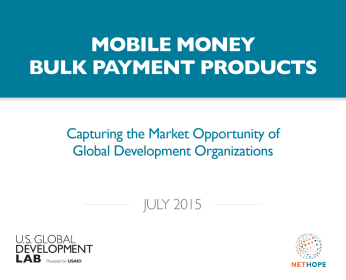
Mobile Money Bulk Payment Products: Capturing the market opportunity of global development organizations
Presentation
International relief and development organizations (DOs) receive significant aid funding from donors, which they regularly disburse in high volume, low value payments to millions of recipients for program and operational expenses. DOs and donors are increasingly using and promoting the use of new digital...
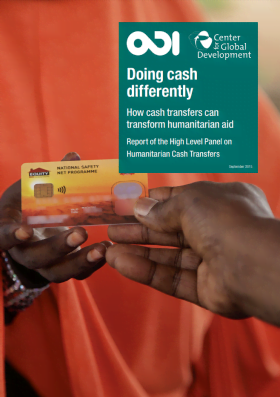
Doing Cash Differently: How cash transfers can transform humanitarian aid?
Policy paper
This report commissioned by the Overseas Development Institute highlights why giving aid directly in the form of cash is often a highly effective way to reduce suffering and to make limited humanitarian aid budgets go further. The publication, ,written by the High Level Panel on Humanitarian...
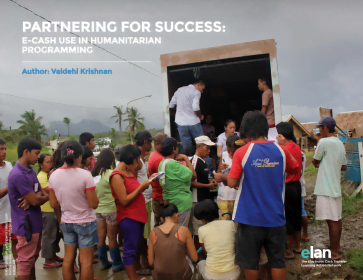
Partnering for Success: E-cash use in humanitarian programming
Policy paper
In recent years, new technologies have facilitated electronic cash transfers (e-transfers) to disaster- and conflict-affected populations. Utilizing e-cash in emergency response requires close partnerships with Financial Service Providers (FSPs), often in places where electronic payments are still...

Cash in Emergencies Toolkit
Guidelines and Tools
Access Toolkit Here Cash transfer based programming (CTP) is an effective and flexible way to support people affected by emergencies, maintaining their dignity and choice, while fostering local economies. CTP includes all forms of cash and voucher-based assistance. The Cash in Emergencies Toolkit has been...

Challenges and the State of Play of Interoperability in Cash Transfer Programming
Guidelines and Tools
This study explores the factors driving the design of interoperability for Cash Transfer Programming. It outlines the rapidly changing environment in which digital services are emerging, the types of digital collaborations that could be enabled, and the key design challenges that confront effective...
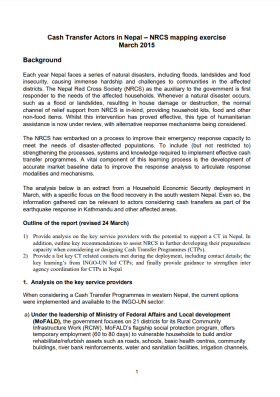
Cash Transfer Actors in Nepal – NRCS Mapping Exercise
Report
Each year Nepal faces a series of natural disasters, including floods, landslides and food insecurity, causing immense hardship and challenges to communities in the affected districts. The Nepal Red Cross Society (NRCS) as the auxiliary to the government is first responder to the needs of the affected...
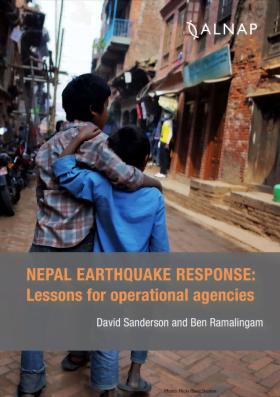
Nepal Earthquake Response: Lessons for operational agencies
Policy paper
In the aftermath of the April 2015 earthquake in Nepal, this paper looks at lessons drawn from previous comparable disasters and seeks to provide invaluable information and assistance to the operational agencies responding to the crisis. Seventeen Lessons give an overview of important learnings based on...
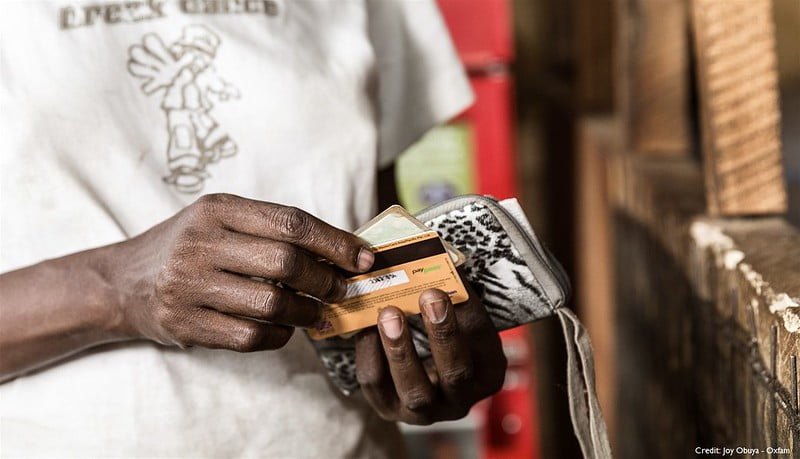
Cash Transfers: Progress made but challenges remain
Blog Post
In five years cash programming has come from almost nowhere to being – for some donors at least – the preferred option, especially in the field of food and nutrition. “We no long measure food aid contributions in wheat/tons equivalent,” says Julia Stewart-David of the EU aid body, ECHO. “That...

USAID Procurement Executive’s Bulletin 2014-06
Policy paper
This Bulletin applies to USAID’s Acquisition Workforce consisting of Contracting Officers (COs), Agreement Officers (AOs), Negotiators, CO/AO Representatives (CORs/AORs), and Activity Managers worldwide. The purpose of this bulletin is to provide guidance to the Acquisition Workforce on promoting...
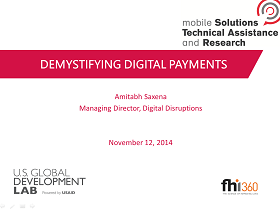
Demystifying Payments – mStar
Report
In its simplest form, a payment is any exchange of value between two parties, where usually Party A offers a form of currency in exchange for a good or service provided by Party B. The advent of nation-states issuing fiat currency, such as paper bills and bronze coins, which unlike gold or silver...
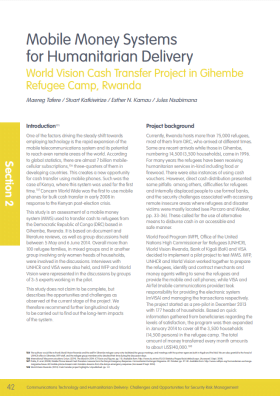
Mobile Money Systems for Humanitarian Delivery: World Vision cash transfer project in Gihembe refugee camp, Rwanda
Report
One of the factors driving the steady shift towards employing technology is the rapid expansion of the mobile telecommunications system and its potential to reach even remote areas of the world. According to global statistics, there are almost 7 billion mobilecellular subscriptions, three-quarters of them...
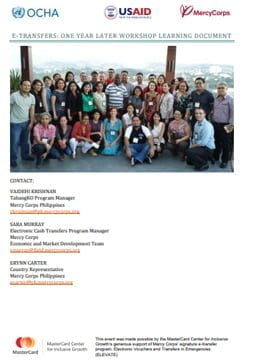
E-Transfers: One Year Later Workshop Learning Document
Report
In the aftermath of Typhoon Haiyan (known locally as Typhoon Yolanda), an estimated half million storm-affected Filipinos received an electronic cash transfer (e-transfer) to help them rebuild and recover from the storm’s devastation. The presence of a large number of Financial Service Providers...
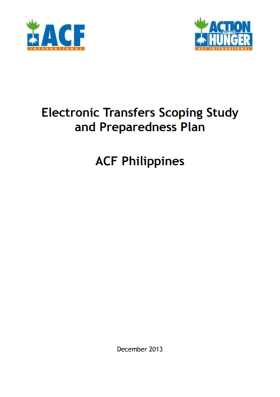
Electronic Transfers Scoping Study and Preparedness Plan
Policy paper
This piece of work was arranged by Action Against Hunger (ACF), with the intention of understanding the electronic payment services available in a minimum of two country missions and to support ACF in preparing for future humanitarian response in country and globally, with a specific focus on...

Disaster Response: Mobile Money for the Displaced
Report
Advances in mobile technology have opened up new opportunities, not only for communication, but also for using the mobile handset as a platform for a range of applications. The introduction of data transfer facilities and the rise of mobile financial services around the world have allowed mobile money...

Factors Affecting the Cost-efficiency of Electronic Transfers in Humanitarian Programmes
Report
Led by Oxford Policy Management (OPM) with support from Concern Worldwide, this research aims to answer the key question: Are electronic transfers more cost-efficient than traditional manual based cash delivery methods, and under what conditions? Cash is increasingly offered to households in...

Unconditional Cash Assistance via E-Transfer: Implementation lessons learned – Winterization support via CSC bank ATM card
Report
This document looks at the lessons learned from the Danish Refugee Council’s e-transfer programme designed to provide cash assistance to Syrian refugees in Lebanon using the CALP Network’s guidelines on e-transfers in emergencies as a point of reference for assessing adherence to best practices.

Payment Mechanisms and Anti-Poverty Programs: Evidence from a Mobile Money Cash Transfer Experiment in Niger
Report
Cash transfers have become an increasingly important component of social protection policies in both developed and developing countries. While such programs are often implemented electronically in developed countries, in many developing countries with weak financial infrastructure, such transfers are...
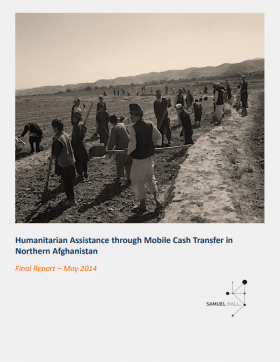
Humanitarian Assistance through Mobile Cash Transfer in Northern Afghanistan: An evaluation of a DFID pilot project in Faryab, Jawzjan, and Samangan
Report
In response to the 2011 severe drought that pushed vulnerable rural households into food insecurity in 14 provinces of Northern Afghanistan, DFID has committed to address emergency needs in northern Afghanistan with nutrition, food security and farming inputs. Samuel Hall Consulting, a Kabul-based...
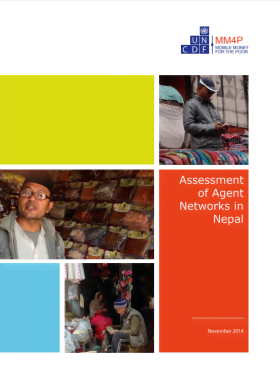
Assessment of Agent Networks in Nepal
Report
This report focuses on assessing the existing agent networks in Nepal, so that the correct steps can be taken to popularise both access to and use of financial services through bank-led agent banking. After the release of electronic banking regulations in 2012, many financial institutions began...
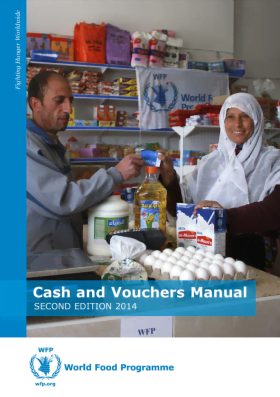
Cash and Vouchers Manual – Second edition
Guidelines and Tools
This second edition of the Cash and Vouchers Manual captures the latest corporately endorsed business processes and procedures, providing the most up-to-date tools (i.e. analytical, assessment, monitoring) that have been developed through close intra-departmental collaboration between Headquarters...


